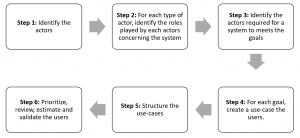Chapter 5: Use-Case Models
Learning Goals
- Describe the importance of a use-case model
- Identify the 3 components of a use-case model
- Create a use-case diagram
Introduction
A use-case model is a set of typical scenarios for a system that primarily describes functional (behavioural) requirements. Use-cases are text stories that model system-user interactions that can be used to discover and record requirements. The need for use-case diagrams arises during the early stages of a project. These models increase readability and understanding of the system.
A use-case model can benefit parties both on the development side and on the investment side. Developers may lose sight of the actual requirements of a system amidst all the technical difficulties they may face. Use-case models can help focus and track the core requirements needed in the system [1].
Components of a Use-Case Model
There can be variations in styles and templates used for different purposes and by different organizations. Typically, a use-case diagram contains the following three components:
(1) Actors
Actors are individuals (human or non-human) involved with the system. To identify the actors, consider the following questions [1]:
- Who uses the system?
- Who are the people involved in the functional maintenance of the system? (E.g., installation, start-up, shut down)
- Who provides information to the system, and who is on the receiving end of that information?
There are three types of actors: Primary, Supporting, and Offstage. Primary actors include main actors whose goals will directly be fulfilled by the system. Supporting actors can either be a computer system, person, or an organization that supports the system through services. Offstage actors are those who are interested in the working of the system. Remember that it is also possible to incorporate “empathy” to address actor needs. This can be accomplished by conducting research to determine how best to approach the need, including interviews with specific actors who can identify clearly how they intend to interact (or what they need from) the system under discussion.
(2) Use-Cases
A use-case denotes how the system can be used to accomplish the desired goal. The use-case also needs to include details about the activities and variants involved in the process. It can be thought of as a sequence of actions and interactions between actors and the system. Use-cases often describe related success and failure scenarios with respect to an actor using a system. Note the distinction between this “use-case” (the set of examples that can be created to demonstrate the system) and the use-case model, of which use-cases are one component.
(3) Relationships
There should be a clear indication of how the actors are related to the system by correctly identifying the use-cases in which they participate. This can also include dependencies between the use cases. Identifying relationships accurately and clearly helps to uncover potential issues, backlogs, challenges, and opportunities while the system is under development.
Creating a Use-Case Diagram
Warren Lynch [2] outlines the following steps, Figure 1, below, for developing a use-case diagram.

Now, let’s consider how we might apply the use-case diagram steps to an actual example. Review Video 1, below, where Antony Della Porta highlights the process and actors in a use-case [3].
Video 1. An application of the use-case diagram steps with a specific example [3].
Key Points
- Use-case models describe the functional requirements in a system
- Use-case models increase readability and comprehension of what actions take place in a system
- The components in a use-case model are Actors, Use-Cases, and Relationships
References
[1] “Use Case Modeling”, W3Computing, https://www.w3computing.com/systemsanalysis/use-case-modeling/ [Accessed January 1, 2022].
[2] W. Lynch, “All You Need to Know about Use Case Modeling”, [March 22, 2019] https://warren2lynch.medium.com/all-you-need-to-know-about-use-case-modeling-828756da3215 [Accessed January 1, 2022].
[3] A. Della Porta, Business Modelling – Use Case Diagrams: Tools and Techniques, (Dec. 12, 2019)., The Sustainable PM, [Online Video]. https://www.youtube.com/watch?v=86v6a5B4WMc. [Accessed November 12, 2021].

